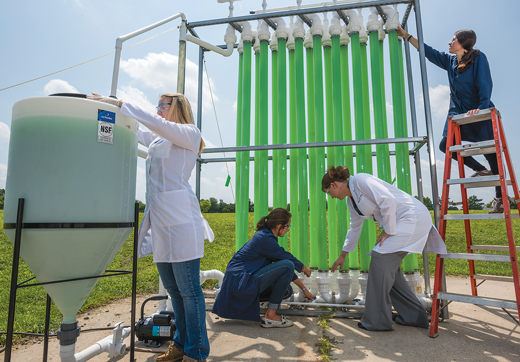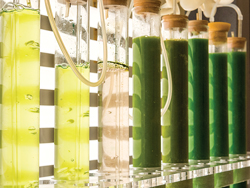

Fuel of the Future
OUR UD | Carbon dioxide gives soda its fizz and champagne its sparkle. But increased levels of carbon dioxide in the atmosphere due to human activities can cause the earth to warm and oceans to acidify at alarming rates.

Scientists have long sought to find clean, green alternatives to fossil fuels like gasoline, which exacerbate the carbon dioxide problem, and biofuels—fuels derived from biological resources such as plants or plant biomass—are considered a renewable solution.
At the University of Delaware, associate scientist Jennifer Stewart is working to create sustainable algae-based biofuels that could reduce carbon dioxide and other harmful emissions in the atmosphere.
Done right, it could solve many problems.
An imperfect solution
Algae can produce 12 times more biodiesel per acre than plants, such as corn or sugarcane, and can be grown in arid areas, like deserts, where it doesn’t take up land used to grow food. Marine algae can be grown using seawater, saving freshwater supplies for more pressing purposes like drinking water.

But using algae to produce biofuels hasn’t been all that easy—or cheap.
Growing algae at commercial scales requires more carbon dioxide than is present in the atmosphere, forcing commercial producers to purchase bottled carbon dioxide instead. This is a disadvantage both from a financial and an environmental perspective.
Many scientists have proposed growing algae on power plant smokestacks to neutralize their emissions, which typically contain high levels of nitric oxide and carbon dioxide gases. Nitrogen oxides in industrial emissions are highly toxic and contribute to acid rain and ground-level ozone, while also damaging human health and destroying food crops.
“But what if we could capture or redirect these emissions for a usable purpose?” asks Stewart, an associate scientist in UD’s School of Marine Science and Policy, housed in the College of Earth, Ocean, and Environment.
Inventing tomorrow
Up until now, the challenge has been to keep the algae alive in the presence of nitric oxide gas, which is toxic to most algal species.
As a doctoral student at UD working with biochemist Kathryn Coyne, Stewart studied Heterosigma akashiwo, a species of algae that thrives in Delaware waterways and worldwide. Stewart discovered that H. akashiwo contains a special enzyme with the unique ability to convert nitric oxide gas into a form of nitrogen it can use for food.
So instead of dying in the presence of toxic emissions—H. akashiwo thrives.
This discovery may help push algae into the major leagues of biofuel sourcing.
The tiny, plant-like algae starts out as a single-celled organism, invisible to the naked eye. When it comes in contact with sunlight, water and a food source (such as carbon or nitrogen), it reproduces faster than other plants and can grow from a few cells to millions of cells in just one liter of water over a matter of days.
Once harvested, the golden-brown colored algae can be transformed into algae-based biofuels, bioplastics and even algae-based, omega-3 supplements.
A question of scale
Stewart is now reviewing every step in the cultivation process—culturing the algae in the laboratory, determining what concentrations of carbon dioxide produce the highest algae growth and, ultimately, understanding the best way to harvest the algae for the greatest yield. It is work that builds on previous trials she conducted with colleagues at the Arizona Center for Algae Technology and Innovation.
This summer she installed a bioreactor (pictured on pages 33 and 34) outside of Sharp Laboratory on UD’s Hugh R. Sharp Campus in Lewes to test how much algae can be grown and harvested over a given period of time. She believes that Delaware is a prime place to conduct this research because while the Mid-Atlantic region has its own sources of pollution, natural wind patterns across the country bring pollution here from states to the north and northwest, too.
Her immediate efforts are on addressing challenges in cost and scalability in hopes of reducing costs of algae farming to be competitive with the price of gasoline.
If successful, Stewart’s work might just provide algae the muscle to go to market.
Stewart believes that algae has a huge role to play in alternative fuels and can easily envision a large portion of U.S. transportation fuels being replaced by algal biofuels in the foreseeable future—though she concedes that the journey is not without its challenges.
“We are at a very pivotal moment right now. I think we will see companies commercializing and making profits in the next ten years, but cost will be a determining factor,” she says. “We know we can make algal biofuels, but can we do it economically? That is the more important question.”
She hopes to have those answers soon.
Article by Karen B. Roberts, AS90
Stewart’s breakthrough has led to collaborations with the Arizona Center for Algae Technology and Innovation at Arizona State University and University of Kentucky’s Center for Applied Energy Research, among others, and garnered funding from the USDA, National Science Foundation, U.S. EPA (STAR) program, Delaware Sea Grant, Department of Energy and other industry partners.
Web Extra: View a video on Stewart’s algae biofuels research.




